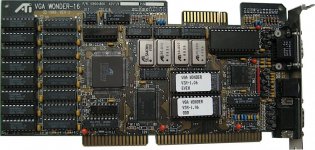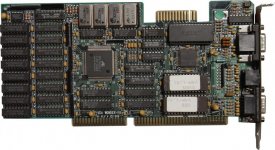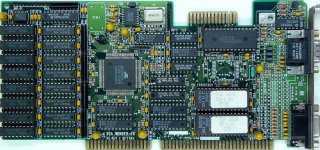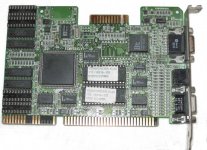The ATi Wonder Series represents some of the first graphics add on products for [wiki]IBM[/wiki] Personal computers and compatibles introduced by ATi Technologies in the mid to late 1980s. These cards were unique at the time as they offered the end user a considerable amount of value by combining support for multiple graphics standards (and monitors) into a single card. The VGA Wonder series added additional value with the inclusion of a bus mouse port, which normally required the installation of a dedicated Microsoft Bus Mouse adapter.
The VGA Wonder series later merged with the [wiki]Hardware:ATi Mach Series[/wiki] of cards in 1990. The ATi Graphics Ultra (VRAM) and ATi Graphics Vantage (DRAM) cards both featured independent VGA Wonder ASICs in addition to their Mach8 8514 compatible coprocessor chips. The Graphics Ultra was later renamed the VGA Wonder GT. In 1992, their following product line, the Mach32, integrated the VGA wonder core and coprocessor into a single IC. At this point the VGA Wonder line was cancelled and replaced with a cost reduced DRAM based version of Mach32 known as the "ATi Graphics Wonder".
[h="2"]MDA/CGA Cards[/h]
[h="2"]EGA Cards[/h]
[h="2"]VGA Cards[/h]
ATi VGA Integra (1990)
The VGA Wonder series later merged with the [wiki]Hardware:ATi Mach Series[/wiki] of cards in 1990. The ATi Graphics Ultra (VRAM) and ATi Graphics Vantage (DRAM) cards both featured independent VGA Wonder ASICs in addition to their Mach8 8514 compatible coprocessor chips. The Graphics Ultra was later renamed the VGA Wonder GT. In 1992, their following product line, the Mach32, integrated the VGA wonder core and coprocessor into a single IC. At this point the VGA Wonder line was cancelled and replaced with a cost reduced DRAM based version of Mach32 known as the "ATi Graphics Wonder".
[h="2"]MDA/CGA Cards[/h]
| Release year | P/N | Name | Chipset | Memory | Display modes | I/O | Notes | Photo |
| 1985 | Color Emulation Card | 16KB, At least | At least CGA emulation | At least monochrome TTL, problably also RGBI TTL | This card was mentioned once in an online competition, but little is known about them except that Commodore bought some for use in their products. | |||
| 1986 | 168228 | Graphics Solution | ATI CW16800-A/ATI CW16800-B, 6845 | 64KB of DRAM | At least CGA and MDA emulation | Monochrome and RGBI TTL, Optional parallel port if 168229 expansion board is installed (only on some cards) | Possibly a renamed version of the "Color Emulation Card". | [wiki="Image:GSSP.jpg"]175px|right|frameless|Graphics Solution[/wiki] |
| 1987 | 168238 | Graphics Solution Plus SP (Serial/Parallel) | ATI CW16800-B, 6845 | 64KB of DRAM | CGA (Plantonics color+) and MDA (Hercules) emulation | Monochrome and RGBI TTL, Serial and Parallel ports | ||
| 1987 | 168248 | Graphics Solution Plus | ATI CW16800-B, 6845 | 64KB of DRAM | CGA (Plantonics color+) and MDA (Hercules) emulation | Monochrome and RGBI TTL | [wiki="Image:GraphicsSolutionPlus.jpg"]175px|right|frameless|Graphics Solution Plus[/wiki] | |
| 168328 | Graphics Solution SR (Static-RAM) | ATI CW16800-B, 6845 | 64KB of SRAM | CGA (Plantonics color+) and MDA (Hercules) emulation | Monochrome and RGBI TTL | [wiki="Image:GraphicssolutionSR.jpg"]175px|right|frameless|Graphics Solution SR[/wiki] | ||
| 1988 | 18701 | Graphics Solution SC (Single-Chip), Small Wonder Graphics Solution version 1 | ATI 18700 | 64KB of SRAM | CGA (Plantonics color+) and MDA (Hercules) emulation | Monochrome and RGBI TTL, Composite output or Gameport | Made in several different variants, some with a gameport instead of the composite output, some with alternative font ROMs and some lacked both the composite output and gameport. The name was changed to "Small Wonder Graphics Solution version 1" shortly after launch. | [wiki="Image:Swgsv1.jpg"]175px|right|frameless|Small Wonder Graphics Solution version 1[/wiki] |
| 1988 | 18703 | Small Wonder Graphics Solution version 2 | ATI 18700 | 64KB of SRAM | CGA (Plantonics color+) and MDA (Hercules) emulation | Monochrome and RGBI TTL, Composite output | [wiki="Image:Swgsv2.jpg"]200px|right|frameless|Small Wonder Graphics Solution version 2[/wiki] | |
| 1988 | 109005100 | Small Wonder Graphics Solution version 3 | ATI 18700 | 64KB of SRAM or DRAM | CGA (Plantonics color+) and MDA (Hercules) emulation | Monochrome and RGBI TTL, Composite output (optional) | [wiki="Image:Smallwonderv3.jpg"]200px|right|frameless|Small Wonder Graphics Solution version 3[/wiki] |
| Release year | P/N | Name | Chipset | Memory | Display modes | I/O | Notes | Photo |
| 1987 | 16890 | EGA Wonder Series 1 | 256KB of DRAM | CGA and MDA (dual-page Hercules) emulation. EGA | Monochrome, RGBI, and RrGgBb TTL, Composite outputs | |||
| 1987 | 16892 | EGA Wonder Series 2-4 | 256KB of DRAM | CGA and MDA (dual-page Hercules) emulation. EGA and Extended EGA | Monochrome, RGBI and RrGgBb TTL, Composite outputs | [wiki="Image:Egawonderseries24.jpg"]200px|right|frameless|ATi EGA Wonder Series 2-4[/wiki] | ||
| 1987 | 16900, 104001500 | EGA Wonder 800 | ATI 16899-0, CHIPS P82C435 | 256KB of DRAM | CGA, MDA (dual-page Hercules) and 16-color VGA emulation. EGA and Extended EGA | Monochrome, RGBI and RrGgBb TTL, Composite outputs | Some models had surface mount DRAMs | [wiki="Image:Egawonder800.jpg"]200px|right|frameless|ATi EGA Wonder 800[/wiki] |
| 1988 | 16900, 104001500 | EGA Wonder 480 | ATI 16899-0, CHIPS P82C435 | 256KB of DRAM | CGA, MDA (dual-page Hercules) and 16-color VGA emulation. EGA and Extended EGA | Monochrome, RGBI and RrGgBb TTL | Cost reduced model. Soldered DRAM. No feature connector/composite | [wiki="Image:Egawonder480.jpg"]200px|right|frameless|ATi EGA Wonder 480[/wiki] |
| 1988 | 109006000 | EGA Wonder 800+ | ATI 18800-1 | 256KB of DRAM | CGA, MDA (dual-page Hercules), EGA and Extended EGA emulation. 16-color VGA | Monochrome, RGBI and RrGgBb TTL | Rebadged "VGA Edge" lacking the analogue VGA port | [wiki="Image:Egawonder800plus.jpg"]200px|right|frameless|ATi EGA Wonder 800+[/wiki] |
- Cost reduced version based on new ATi 28800 ASIC
- Lacks bus mouse connector
- Uses a much smaller PCB with a surface mount BIOS & RAMDAC
- Supports SVGA Graphics with 72 Hz refresh rates
- 512KB DRAM
- PCB layout similar to VGA Integra but using cheaper RAMDAC
- Only supports the basic 60 Hz VGA modes of the IBM VGA standard from 1987
- 256KB DRAM (not upgradable)
- Similar to VGA Basic-16, but can be upgraded to 512KB
- Chipset: ATI 28800
- Combines a VGA Wonder XL with a Sound Blaster 1.5
- Features "fake" stereo sound
- 512KB or 1MB DRAM
- A series of OEM or cost reduced versions of several VGA Wonder models
- Typically lacks the bus mouse connector and/or the digital TTL output
- The ATI produced variants were mostly based on previous cards with features removed, either in BIOS or by using lower quality parts.





